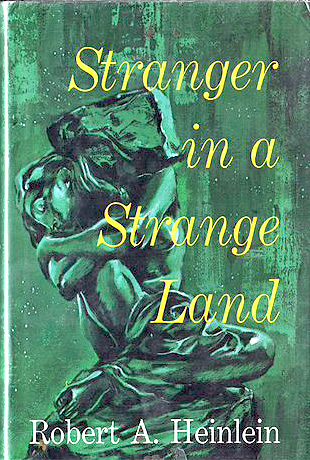 “We grok god.”
“We grok god.”
And so the fascinating story of Valentine M. Smith unravels in Stranger in a Strange Land, beloved science fiction classic authored by Robert A. Heinlein, renowned giant in the world of science fiction.
The story hooks with unexpected ferocity and its wit and eccentricities keep readers fascinated and reading until the sudden, brutal and unexpected end. Chronicling the story of Valentine Smith, an Earthling who was raised in Mars and who now comes to Earth to act as a Martian missionary, Robert A. Heinlein raises probing questions about our beliefs as human beings, our inherit society’s structure and our understanding of the cosmos. Scrutinizing our “human” nature through alien eyes, he brings to mind questions that are just as relevant today as they would have been in Heinlein’s contemporary time.
The book, though separated essentially into four parts, is a dualistic book, distinctly divided between Smith’s inchoation and later, his fully-fledged development. The first focuses on secondary characters and gives them life – Valentine Smith’s character is rough-cut and hewn irregularly, and the book only gives him a cursory look. His monosyllabic sayings and strange, awkward and assiduous manner – from his impeccable English to sudden withdrawals from the world – alienate him from readers and deprive him of a fundamental human element – a fact the government exploits to the best of its abilities.
But Heinlein’s genius comes in this subtle change; he allows Smith’s character to polish itself and truly define itself only in the second half of the book – and here, the central conflict changes from being government corruption to human nature. By running the gambit of the government “secret dark room” to public stoning, Heinlein paints a cohesive picture of our society and our lives.
Heinlein provides a social critique of the world that is still very much applicable today. He questions the basis of religion, taboos in society and our revulsion to close contact with strangers. With Smith, he paints a “what if?” world of tomorrow, a question that leads to the book’s stunning climax.
No doubt, Stranger in a Strange Land has its rough edges. The sharp and acerbic take it has on religion is sure to make more than a few readers hesitate and grimace. And the book is restricted by the psychological dimensions of its time: sexism prevails and triumphs: the central characters casually drop sexist remarks and the female characters, despite Heinlein’s efforts, come off as flat and trite – unlike the male characters, there is no real sharp difference that distinguishes the female cast from each other.
Despite this, there’s no doubt that Stranger in a Strange Land’s dubious title as “the most famous science fiction novel ever published” is well deserved. It offers a new look at our lives and sharply probes at our conscious minds, forcing what was thought of as “natural” to be realized as convoluted and strange. The book has its strange eccentricities: its coinage of “grokking,” its alien and improbable solutions to our problems as a society and the wildly improbable characters – but take a closer look and you’ll find that these eccentricities only serve to draw the reader in. As a classic of provoking thought, it’s clear message still very much cuts to our contemporary society.

